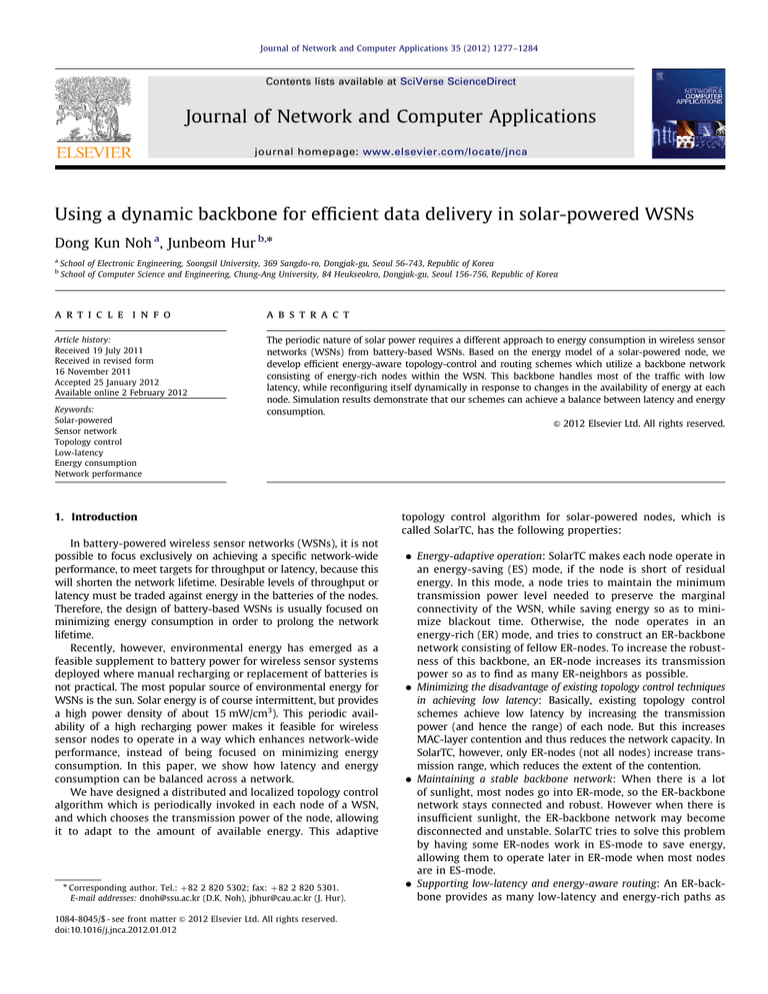
Journal of Network and Computer Applications 35 (2012) 1277–1284
Contents lists available at SciVerse ScienceDirect
Journal of Network and Computer Applications
journal homepage: www.elsevier.com/locate/jnca
Using a dynamic backbone for efficient data delivery in solar-powered WSNs
Dong Kun Noh a, Junbeom Hur b,n
a
b
School of Electronic Engineering, Soongsil University, 369 Sangdo-ro, Dongjak-gu, Seoul 56-743, Republic of Korea
School of Computer Science and Engineering, Chung-Ang University, 84 Heukseokro, Dongjak-gu, Seoul 156-756, Republic of Korea
a r t i c l e i n f o
abstract
Article history:
Received 19 July 2011
Received in revised form
16 November 2011
Accepted 25 January 2012
Available online 2 February 2012
The periodic nature of solar power requires a different approach to energy consumption in wireless sensor
networks (WSNs) from battery-based WSNs. Based on the energy model of a solar-powered node, we
develop efficient energy-aware topology-control and routing schemes which utilize a backbone network
consisting of energy-rich nodes within the WSN. This backbone handles most of the traffic with low
latency, while reconfiguring itself dynamically in response to changes in the availability of energy at each
node. Simulation results demonstrate that our schemes can achieve a balance between latency and energy
consumption.
& 2012 Elsevier Ltd. All rights reserved.
Keywords:
Solar-powered
Sensor network
Topology control
Low-latency
Energy consumption
Network performance
1. Introduction
In battery-powered wireless sensor networks (WSNs), it is not
possible to focus exclusively on achieving a specific network-wide
performance, to meet targets for throughput or latency, because this
will shorten the network lifetime. Desirable levels of throughput or
latency must be traded against energy in the batteries of the nodes.
Therefore, the design of battery-based WSNs is usually focused on
minimizing energy consumption in order to prolong the network
lifetime.
Recently, however, environmental energy has emerged as a
feasible supplement to battery power for wireless sensor systems
deployed where manual recharging or replacement of batteries is
not practical. The most popular source of environmental energy for
WSNs is the sun. Solar energy is of course intermittent, but provides
a high power density of about 15 mW/cm3). This periodic availability of a high recharging power makes it feasible for wireless
sensor nodes to operate in a way which enhances network-wide
performance, instead of being focused on minimizing energy
consumption. In this paper, we show how latency and energy
consumption can be balanced across a network.
We have designed a distributed and localized topology control
algorithm which is periodically invoked in each node of a WSN,
and which chooses the transmission power of the node, allowing
it to adapt to the amount of available energy. This adaptive
n
Corresponding author. Tel.: þ82 2 820 5302; fax: þ 82 2 820 5301.
E-mail addresses: dnoh@ssu.ac.kr (D.K. Noh), jbhur@cau.ac.kr (J. Hur).
1084-8045/$ - see front matter & 2012 Elsevier Ltd. All rights reserved.
doi:10.1016/j.jnca.2012.01.012
topology control algorithm for solar-powered nodes, which is
called SolarTC, has the following properties:
Energy-adaptive operation: SolarTC makes each node operate in
an energy-saving (ES) mode, if the node is short of residual
energy. In this mode, a node tries to maintain the minimum
transmission power level needed to preserve the marginal
connectivity of the WSN, while saving energy so as to minimize blackout time. Otherwise, the node operates in an
energy-rich (ER) mode, and tries to construct an ER-backbone
network consisting of fellow ER-nodes. To increase the robustness of this backbone, an ER-node increases its transmission
power so as to find as many ER-neighbors as possible.
Minimizing the disadvantage of existing topology control techniques
in achieving low latency: Basically, existing topology control
schemes achieve low latency by increasing the transmission
power (and hence the range) of each node. But this increases
MAC-layer contention and thus reduces the network capacity. In
SolarTC, however, only ER-nodes (not all nodes) increase transmission range, which reduces the extent of the contention.
Maintaining a stable backbone network: When there is a lot
of sunlight, most nodes go into ER-mode, so the ER-backbone
network stays connected and robust. However when there is
insufficient sunlight, the ER-backbone network may become
disconnected and unstable. SolarTC tries to solve this problem
by having some ER-nodes work in ES-mode to save energy,
allowing them to operate later in ER-mode when most nodes
are in ES-mode.
Supporting low-latency and energy-aware routing: An ER-backbone provides as many low-latency and energy-rich paths as
1278
D. Kun Noh, J. Hur / Journal of Network and Computer Applications 35 (2012) 1277–1284
possible from ER-nodes to the sink node. Therefore, low-latency
routing or energy-aware routing can be effectively implemented
on the ER-backbone.
Our final goal is to design an efficient routing scheme, which
can achieve a balance between latency and energy-consumption
using an ER-backbone constructed by SolarTC. This scheme is
called ER-backbone-based geographic routing (ERB-GR), and it
has the following characteristics:
Low-latency routing within an ER-backbone: The ER-nodes
which form an ER-backbone network have a higher transmission power than ES-nodes. Therefore, the average hop count
along a route from a node to a sink on ER-backbone is less than
that for the same journey over the original topology. ERB-GR
routes data along the ER-backbone to reduce latency. ERB-GR
also considers the duty-cycle of each node, which is the
proportion of time for which it is active. This is important in
energy-harvesting WSNs which have a low duty-cycle, due to
the intermittent availability of environmental energy.
Low-energy-consumption routing on ES-nodes: To extend the
duty-cycle of the node so as to maximize the amount of data
acquired, each ES-node should use as little energy as possible
in routing data. Therefore, when ERB-GR is running on an
ES-node, it routes the data to the ER-backbone in an energyefficient manner.
Energy balance among nodes: ERB-GR routes most of the sensory
data to the sink via ER-nodes which have enough extra energy to
transfer data. This allows ES-nodes to save energy. The set of
ER-nodes which make up the ER-backbone is modified over time,
as it adapts to changing amounts of residual energy at each node.
Guaranteed delivery: Even though the ER-backbone is not
connected, ERB-GR will deliver data reliably to the sink as
long as the network as a whole remains connected. Since the
first step in our topology control is to construct a connected
network, ERB-GR can always provide guaranteed delivery.
The rest of this paper is organized as follows. In the next section
we explain existing topology control schemes and routing schemes
for Solar-powered WSNs. Section 3 explains a simple but efficient
solar-energy model, which is used by SolarTC described in Section 4.
Section 5 explains ERB-GR, which operates in a network constructed
by SolarTC. We then evaluate the performance of our scheme in
Section 6, and draw conclusions in Section 7.
2. Background
2.1. Effects of topology control in WSNs
Topology control creates and maintains a list of the immediate
neighbors of a node in a network. It is related to both routing and
the MAC (medium access control) layer in the protocol stack, as
shown in Fig. 1. Topology control can trigger a route update when it
detects that the list of neighbors of the node on which it is running
has changed substantially. By doing this, instead of passively waiting
for the routing protocol to update each route separately, topology
control provides the routing layer with a faster response to topology
changes and a reduced packet-loss rate. Conversely, the routing
layer will trigger execution of topology control if it detects many
broken routes in the network. The presence of broken routes
indicates that the network topology has changed substantially since
the last execution of topology control.
Topology control also determines the transmission range of
the node on which it is running. The transmission ranges of all
nodes determine the expected contention in the MAC layer. Thus,
Trigger route update
Trigger TC execution
Routing Layer
Topology
Control
MAC Layer
Set the power level
Trigger TC execution
Fig. 1. Interactions between topology control and the routing/MAC layer.
the efficiency of topology control directly affects that of the MAC
layer. Conversely, the MAC layer can trigger execution of topology
control if it discovers new neighbors by overhearing network traffic.
Since the effectiveness of topology control is closely related to
the performance of the routing and MAC layers as described above,
it is one of the most important issues in designing efficient WSNs.
The use of topology control to enhance the overall performance of
WSNs has been studied (Santi, 2005; Li et al., 2003; Ramanathan and
Rosales-Hain, 2000), but not for the special case of solar-powered
WSNs.
2.2. Routing in energy-harvesting WSNs
In the literature, most studies of energy-aware routing focus on
residual battery status and do not take into account the environmental energy availability at the nodes. Willig et al. (2002) were the
first to develop a routing protocol for nodes with a renewable power
supply. Although a lot of work has subsequently been put into the
design and development of solar-powered sensor nodes, only a few
makeshift topologies and routing protocols have been implemented.
At a time when energy-harvesting techniques were less effective,
there was some research (Voigt et al., 2003, 2004) on integrating a
small number of solar-powered nodes into an otherwise batterypowered sensor network. The well-known routing protocols, LEACH
(Heinzelman) and Directed Diffusion (Intanagonwiwat et al., 2000),
were modified to prolong network activity by placing heavier
workloads on these additional energy-harvesting nodes.
The first serious attempt to utilize environmental energy for
routing (Kansal and Srivastava, 2003) demonstrated that environmentally aware decisions improve performance compared to
decisions based only on battery status, although the application
scenario was limited. Then, in the Heliomote (Kansal et al., 2007)
project, perpetuity of operation was considered in the context of
task management, network topology and the routing protocol.
The UCLA team’s implementation of a prototype harvesting node,
itself called ‘Heliomote’, suggested ways to model energy harvesting and consumption numerically, and resulted in the design of a
scheme to achieve indefinite operations.
Recently, Noh et al. have studied QoS-aware routing (Noh
et al., 2007) and low-latency routing (Noh et al., 2008) in solarpowered WSNs. In their WSN, transmission ranges are periodically determined, based on an estimated energy harvest and a
predicted energy consumption. Then, the routing program running at each node selects one of the neighbors of that node which
is likely to provide a desirable transmission performance, including low latency and high reliability. However, this approach is
based on the predictions of variables such as the hop-count to the
sink, the energy harvest and the rate of energy consumption,
which are inevitably inaccurate, and thus its performance is not
always satisfactory.
ID
460098
Title
Usingadynamicbackboneforefficientdatadeliveryinsolar-poweredWSNs
http://fulltext.study/article/460098
http://FullText.Study
Pages
8

